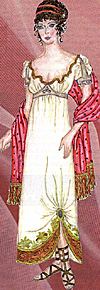
After the Reign of Terror, women's dress outrages the Pope and moralists
After the Thermidorian Reaction, conspicuous consumption revived, and new styles favored by the young, parvenue women known as merveilleuses (marvelous ones) became theatrically fanciful. After the austerity and puritanical zeal of the Terror, fashionable society once again sought extravagant amusement.
While Revolutionary leaders had espoused Greek and Roman ideals of civic virtue and patriotism, the nouveaux riches embraced the exotic lure of antiquity and affected "ancient" dress. Merveilleuses favored, thin, almost transparent, straight gowns with short sleeves, high waists, and low necks. White became an especially popular color and dominated the fashion palette of the early 19th century. The new modes were advertised as being of ancient Greek or Roman inspiration, and often featured shawls and sandals as accessories. Gowns and hairstyles were named for Psyche, Diana, Medusa, Cleopatra, and Titus.
Napoleon's Egyptian campaign (1798-1801) further popularized the vogue for exotic garb like tunics, turbans, and shawls with Eastern patterns. Many dresses featured puffed sleeves ‡ la Mameluke, named for Egypt's ruling caste. Because the dresses of the era revealed the contours of the body and undergarments were reduced to a chemise and abbreviated corset, moralists found the new styles disconcerting. The Pope officially condemned lascivious feminine attire, and doctors asserted that the exiguous gowns were unhealthy. Many of the excessively revealing gowns were for evening balls, since dancing had become a popular fad in Paris during the Directory. Relatively few women routinely wore "see through" garments. Two social leaders who did embrace the most extreme styles were Therese Tallien and Josephine de Beauharnais, both known for their scandalous, amorous affairs.
More Napoleon: Introductory Guide
-
Introduction
Prejudice and Pride
Napoleon in Military School
The Young Artillerist's Double Life
Revolution & Opportunity
Women's Fashion During the Revolution
The Siege of Toulon
Napoleon & Josephine
Women's Fashion during the Directory
Fame & Glory: Italy
Fame & Glory: Egypt
Saviour or Usurper
Battle of Marengo
Civil Achievments
Enlightened Despot or Tyrant
Napoleon's Siblings
The Dawn of Gastronomy
Haydn and Beethoven
Women's Fashion during the Empire
Napoleon's Other Women
The Mashalate and Imperial Eagle
History's Greatest General?
Back to Table of Contents -- Napoleon #17
Back to Napoleon List of Issues
Back to MagWeb Master Magazine List
© Copyright 2001 by Napoleon LLC.
This article appears in MagWeb (Magazine Web) on the Internet World Wide Web.
The full text and graphics from other military history magazines and gaming magazines are available at http://www.magweb.com
Order Napoleon magazine direct